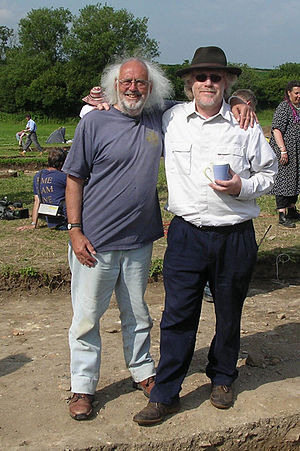Mick Aston

Michael Antony Aston FSA (1 July 1946 – 24 June 2013) was an English archaeologist who specialised in Early Medieval landscape archaeology. Over the course of his career, he lectured at both the University of Bristol and University of Oxford and published fifteen books on archaeological subjects. A keen populariser of the discipline, Aston was widely known for appearing as the resident academic on the Channel 4 television series Time Team from 1994 to 2011.
Born in Oldbury, Worcestershire, to a working-class family, Aston developed an early interest in archaeology, studying it as a subsidiary to geography at the University of Birmingham. In 1970, he began his career working for the Oxford City and County Museum and there began his work in public outreach by running extramural classes in archaeology and presenting a series on the subject for Radio Oxford. In 1974, he was appointed the first County Archaeologist for Somerset, there developing an interest in aerial archaeology and establishing a reputation as a pioneer in landscape archaeology—a term that he co-invented with Trevor Rowley—by authoring some of the earliest books on the subject. In 1978 he began lecturing at the University of Oxford and in 1979 became a tutor at the University of Bristol, supplementing these activities by working as an archaeological tour guide in Greece.
In 1988, Aston teamed up with television producer Tim Taylor and together they created two shows which focused on bringing archaeology into British popular consciousness. The first was the short-lived Time Signs (1991), although this was followed by the more successful Time Team, which was produced for Channel 4 from 1994 to 2013. Aston was responsible for identifying sites for excavation and for selecting specialists to appear on the show, and through the programme became well known to the viewing public for his trademark colourful jumpers and flowing, untidy hairstyle. In 1996 he was appointed to the specially-created post of Professor of Landscape Archaeology at Bristol University, and undertook a ten-year project investigating the manor at Shapwick, Somerset. He retired from his university posts in 2004, but continued working on Time Team until 2011 and in 2006 commenced writing regular articles for British Archaeology magazine until his death. Although Aston did not believe that he would leave a significant legacy behind him, after his death various archaeologists claimed that he had a major impact in helping to popularise the discipline among the British public.
Aston was born on 1 July 1946 into a working-class family in Oldbury, Worcestershire, to cabinet-maker Harold Aston and his wife Gladys.[1][2] He developed an early interest in archaeology, although teachers at Oldbury Grammar School attempted to dissuade him from pursuing it.[2][3] His father gave him two books on archaeology as a Christmas present, and he subsequently spent much time visiting archaeological sites, sometimes playing truant to do so.[4][5] The first of his family to attend university, Aston studied geography at the University of Birmingham, albeit with a subsidiary in archaeology, graduating in 1967.[2][6][7][8] He taught himself more about archaeology by enrolling in various excavations,[1][3][5] and was influenced by such figures as his thesis supervisor Harry Thorpe, as well as the geographer Trevor Rowley and archaeologists Philip Rahtz and Philip Barker.[1][9] His dissertation was on the development of settlement in the West Penwith peninsula in Cornwall.[10]
